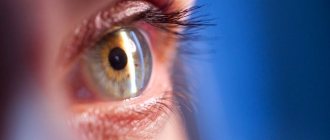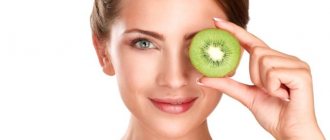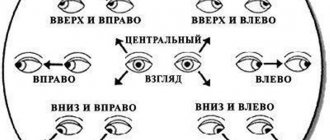People suffering from cataracts often have a lack of vitamins E and C, beta-carotene, zinc, copper, and riboflavin. According to research, zinc deficiency is present in 60% of patients diagnosed with early cataracts. Timely vitamin supplementation at an early stage will help slow down the progression of cataracts. Which vitamins to choose?
In this article
- Vitamins for the eyes for cataracts: benefits
- Visual impairment associated with a lack of nutrients
- Vitamins for the eyes for early cataracts
- Diet and vitamins for cataracts
- Prevention of cataracts with folk remedies
Vitamins for the eyes for cataracts: benefits
A poor diet and an unbalanced diet can cause the progression of ophthalmic diseases in children, adolescents, and adults. Without receiving sufficient quantities of necessary substances, organs undergo changes that affect visual acuity. To prevent cataracts and other eye diseases, as well as to improve the quality of vision, you can take courses of vitamin preparations. Vitamins for the eyes are based on blueberry extract, based on carotenoids, and also combined, which contain blueberry extract, minerals, vitamins B, C, A and carotenoids.
Features of eye vitamins:
- replenish the deficiency of substances necessary for the normal functioning of the optical system of the human eye;
- prevent clouding of the lens, effective for early cataracts;
- protect the organs of vision from the negative effects of external factors, slow down the development of age-related changes:
- relieve eye fatigue, help improve vision clarity, contrast, and color sensitivity.
Vitamin complexes with lutein - a substance that is not produced by the human body, but is necessary because it has antioxidant properties and affects visual acuity, providing clarity and detail in images. Preparations with lutein, zinc, selenium, vitamins C and E are prescribed to prevent visual impairment, cataracts, and to slow down age-related changes in eye tissues.
Why do cataracts and glaucoma occur?
Cataract is an irreversible clouding of the lens and capsule. Often the disease is a consequence of the aging of the body. The following pathologies that provoke cataracts are also significant:
- metabolic disorders;
- diabetes.
The chemical composition in the tissues of the lens changes as natural aging occurs, which is accompanied by the formation of free radicals. They lead to the accumulation of toxic compounds.
Over time, the eye's antioxidant protection weakens. This increases the risk of developing cataracts. Gradually, adverse effects on the tissues of toxins are observed. Irreversible changes occur in the lens of the eye. If treatment, which also includes taking vitamins, is not started promptly, cataracts may occur. Pathology significantly worsens the quality of life.
The causes of cataracts include:
- unfavorable heredity;
- deformation of the lens due to injury;
- pathologies of the endocrine system;
- eye diseases (glaucoma, myopia);
- severe infectious processes;
- Down syndrome;
- burns of the organs of vision;
- eczema, neurodermatitis and other skin diseases;
- prolonged insolation;
- long-term corticosteroid therapy;
- exposure to radiation;
- unfavorable environmental conditions;
- poisoning with heavy metals and toxic substances;
- bad habits (excessive consumption of alcoholic beverages, smoking);
- insufficient sleep.
Sometimes cataracts are congenital. Pathology occurs as a result of previous diseases, which include rubella. Lens abnormality and cataracts may develop if a pregnant woman takes certain medications or has been exposed to radiation.
Attention! Symptoms of cataracts include double vision, blurred vision, increased sensitivity to light, the appearance of a non-existent halo around the light source, impaired color vision, and a feeling of haze.
Glaucoma causes increased pressure in the eyes, which leads to atrophy of the optic nerve. The pathology can progress asymptomatically for a long time. Often, a visit to a doctor is noted when there is a loss of visual acuity.
Glaucoma is considered a dangerous disease that causes blindness if left untreated. Timely therapy can stop the process of optic nerve atrophy. It is not possible to cure the disease completely.
In most cases, glaucoma is bilateral and is associated with a genetic predisposition. If there is a family history, intraocular pressure should be constantly monitored.
Increased pressure in the eyes and the development of cataracts are accompanied by the following symptoms:
- blurred vision;
- narrowing of fields;
- severe pain.
The reasons for the development of glaucoma are due to its varieties:
- congenital;
- secondary;
- open angle;
- closed angle.
Typically, an increase in pressure is associated with a violation of the drainage system of the eyes, leading to a change in the outflow of chamber fluid. Atrophy is caused by stress on the optic nerve. Among the factors that provoke glaucoma are:
- cervical osteochondrosis;
- sclerotic changes in blood vessels;
- lowering blood pressure.
These factors cause insufficient blood supply to the brain. Gradually, visual functions are impaired due to changes in metabolism in the tissues of the optic nerve and eye, and cataracts and glaucoma develop.
Visual impairment associated with a lack of nutrients
A person can receive all useful substances through food, but for this, his diet must be as varied as possible and include different food groups. Organizing a properly balanced diet is difficult, so vitamin preparations come to the rescue to help compensate for the lack of important substances. The selection of a complex of vitamins for the eyes is carried out by an ophthalmologist, focusing on the data obtained during the examination of the patient.
How does a lack of vitamins affect eye health?
- Weakness of the sclera, which normally should be dense to maintain the shape of the eye, occurs due to a lack of zinc, calcium and copper in the body. When stretched for a long time, a weak sclera loses its ability to restore its shape and becomes deformed. To strengthen it, you need to take a special vitamin complex rich in calcium, vitamins A and B.
- Cataract. Low levels of vitamin B2 in the body lead to the fact that important amino acids, such as tryptophan, cannot be absorbed without a sufficient amount of this vitamin, which can lead to the development of cataracts. With a lack of vitamin E, conditions arise under which there is a high risk of clouding of the lens, cornea, and the development of degenerative processes in the retina.
- Conjunctivitis, barley, eye fatigue - all this is associated with a lack of vitamins A and E in the body.
- Weakness of the eye muscles and hemorrhages in the retina are often associated with a deficiency of vitamins B, C, E.
Various visual anomalies are successfully treated with enhanced vitamin supplementation. Patients who have undergone treatment with vitamins, including in the form of eye drops prescribed by a specialist, note significant improvements. Vitamins are especially effective for strengthening the sclera and for treating cataracts at an early stage.
Cataract surgery - side effects after surgery
Many people who have had cataract surgery and lens replacement may experience the following discomforts:
- The eye begins to hurt and ache. But this is a completely normal phenomenon, because as a result of surgery, the outer layer of the retina is damaged. Special eye drops prescribed by a doctor can help get rid of unpleasant and sometimes painful sensations.
- In the eye on which surgery was performed, copious discharge from the lacrimal gland can very often appear. Also, the recovery process may be accompanied by unpleasant itching. Antibiotic drops also help with this.
- Due to the fact that the conjunctival vessels dilate greatly after surgery, the eye may become very red. But don’t be scared, because this is a completely normal and understandable phenomenon.
- After surgery, in some categories of people, vision may not be clear, but blurred. But this is not the doctor’s fault at all. The thing is that the patient already had damage to the retina. But do not worry, because in a few days, this veil will completely disappear, and the person will see clearly and clearly.
All these symptoms may accompany the patient for several days after surgery. But, as a rule, they pass all at once, and the redness and itching completely go away, and the person begins to lead his usual lifestyle.
After cataract surgery, we select glasses
The thing is that after surgery to remove a cataract, instead of the usual lens, the patient is implanted with an artificial implant. As a result of this, a person can perfectly see even the smallest details that are in the distance, but it will be very difficult to see the letters on the pages of a newspaper up close.
In order to solve this problem, he will need specially selected glasses. After three months have passed from the date of surgery, you can visit an ophthalmologist who will check the quality of your vision and write a special prescription for lenses that will allow you to enjoy reading your favorite books or magazines again.
You can make an appointment and ask clarifying questions to our specialists by phone in Moscow (daily from 9:00 to 21:00), using the feedback form on the website.
Mironova Irina Sergeevna
Vitamins for the eyes for early cataracts
Special vitamin preparations that improve metabolism, metabolism in tissues and increase the antioxidant protection of cells can slow down the growth of cataracts. Drops with calcium, magnesium, amino acids improve blood flow to the organs of vision and slow down the processes of change in protein molecules in the lens.
What vitamins should be included in medications to prevent cataracts:
- Vitamin C - necessary for strengthening the retina and blood vessels of the visual organs;
- Zinc, selenium, lutein - improve nutrition of eye tissues, slow down the process of clouding of the lens during cataracts, and help improve metabolism;
- Vitamin A - deficiency of vitamin A can lead to degeneration of the retina and optic nerve, impaired color perception, decreased visual acuity at dusk, retinol is important for maintaining the normal condition of the retina and cornea;
- Vitamins B1, B2, B6 - relieve the feeling of fatigue in the eyes, eliminate discomfort due to increased sensitivity to bright light, increase the acuity of twilight vision, improve focusing, reduce the likelihood of stye, conjunctivitis, and viral eye infections;
- Vitamin E - this vitamin has a powerful antioxidant effect, it is effective in the prevention and treatment of early cataracts, slows down the aging process of the body, improves blood circulation and strengthens the blood vessels of the eyes, and is better absorbed with vitamins A and C.
Nowadays, methods for extracting the clouded lens of the eye from the capsule are well developed and proven, in which it is possible to operate even on immature cataracts, and yet at an early stage, when the effect of vitamins and special drops that dissolve opaque substances is quite effective, few patients decide to undergo surgery . Therefore, the use of vitamins as a prevention and treatment of early cataracts is justified.
Which cataract drops are best?
There are different solutions of eye drops used to treat this disease. They differ in their effectiveness, composition, and cost. The most popular can be considered “Quinax”, “Vitafacol”, “Taufon”, “Vicein”, etc. They quite effectively protect the lens from progressive clouding, but they cannot treat the eyes on their own. An ophthalmologist should prescribe drops after an examination.
Drops are products that can help only in the initial stages of the disease. Very often doctors recommend Taurine. It stimulates recovery processes for various types of problems. "Taurine" is used for senile, diabetic, traumatic, radiation cataracts.
A large number of experts also recommend using Quinax. This remedy was developed by Japanese doctors and is considered very effective in treating cataracts. The main substances of Quinax act on the protein of the lens, protecting it from further clouding. To achieve better results, the drug is used for a long time.
Cataract drops are usually applied to the eye several times a day. Medicines prescribed for the initial stages of the disease include vitamins, biogenic stimulants, and inorganic salts (“Katachrome”, “Secatalin”). Products are used containing glutamic and ascorbic acids, riboflavin. Many drugs also contain nicotinic acid, which facilitates access of ascorbic acid to the tissues of the eye.
Diet and vitamins for cataracts
The diet before and after cataract surgery should be balanced and include foods that are beneficial for eye health. Substances important for vision are found in large quantities in leafy greens, nuts and seeds, dairy products, beef liver, cabbage, bell peppers, cereals, soybeans, and sea fish. In addition to introducing healthy foods into your daily diet, you can take courses of vitamin complexes based on blueberry extract. For increased visual stress, Vitrum Vision vitamins with zinc, lutein and beta-carotene are effective.
Particular attention should be paid to products with a high content of lutein, which prevents the development of degenerative processes in the retina and slows down the aging process of the body, including clouding of the lens. Lutein is found in green and orange vegetables and fruits, egg yolks, nuts, etc. The diet for cataracts should include green peas, spinach, broccoli, parsley, asparagus, zucchini, green onions and avocado.
Restrictions after cataract removal
Life after surgery undergoes changes until the final healing and stabilization of the condition.
Prohibited:
- after cataract surgery, you should not watch TV for a long time; it is better to exclude it from possible pastime;
- sleep on the side of the operated eye;
- apply decorative cosmetics to the eyelids and eyelashes;
- drink alcohol, strong coffee and tea;
- drink plenty of fluids; if this restriction is not observed, there is a risk of edema and increased IOP;
- dye your hair and perm your hair;
- drive a car and engage in potentially hazardous activities;
- be in dusty, smoky rooms, spaces where the air is dry due to the operation of radiators and air conditioners;
- rub the operated eye;
- lift weights more than 5 kg;
- engage in sports, especially those associated with lifting weights and shaking the body;
- hot shower, exposure to the sun, visiting the bathhouse and sauna.
If restrictions and prohibitions are not observed, there is a risk of increased intraocular pressure, corneal edema, retinal detachment and displacement of the new, artificial lens.
Prevention of cataracts with folk remedies
Traditional medicine is also effective in preventing cataracts. Various herbal infusions, decoctions, and teas do a good job of suppressing free radicals. Green tea and herbal teas that contain thyme, chamomile, St. John's wort, and oregano have antioxidant properties. Fresh juices from vitamin-rich foods are also beneficial. Regularly drinking fresh cucumber, beet, blueberry, grape, pumpkin or carrot juice can significantly improve eye health. A sufficient amount of useful vitamins helps improve the functioning of the visual organs and metabolic processes, improves tissue blood flow, and strengthens blood vessels.
Is it possible to do without cataract surgery?
With cataracts, it is necessary to remember that clouding of the lens does not resolve on its own. At the initial stage, drug treatment is still possible, but the drops only slow down the progression of the pathological process without eliminating the disease.
The only way to treat cataracts is surgery. If you previously resorted to wait-and-see tactics, it is now recommended to perform surgery as soon as possible. This allows you to avoid complications and negative effects on eye function, and also get the maximum from treatment.
Surgical therapy for cataracts is safe and proven. Most often, such operations are performed on an outpatient basis. Many people postpone treatment because they consider any surgical intervention dangerous, that is, a last resort. But for cataracts, surgery is the only effective treatment that cannot be postponed. If for some reason the patient wishes to postpone treatment, it is necessary to support the visual system in every possible way during this period.
What foods are good for cataracts?
The diet will only be beneficial if you combine foods correctly and not overuse just one. A balanced menu includes vegetables and fruits, herbs and fresh juices. It is worth choosing foods with a lot of fiber, “healthy” carbohydrates and fats.
For cataracts, you should eat chicken, rabbit and beef, as well as sea fish and seafood. It is advisable to steam or bake meat, and eat vegetables and fruits fresh, since they lose nutrients during heat treatment.
Healthy foods for the visual system
- Cabbage, eggs, spinach, broccoli. Contains powerful antioxidants lutein and zeaxanthin, which strengthen the retina, protect it from damage, and also reduce the risk of cataracts.
- Oranges, strawberries, peaches, red peppers, tomatoes, nettles. Sources of vitamin C that support vascular tone of the eyeball.
- Peanuts, almonds, sunflower seeds, hazelnuts. Replenish vitamin E reserves and protect eyes from free radicals. Vitamin E inhibits the progression of cataracts.
- Red beans, pumpkin seeds, oysters, chicken, beef, seafood. These products contain zinc, which has a beneficial effect on the visual system (transports vitamin A to the retina). Zinc keeps the lens clear and prevents night blindness.
- Salmon, sardines, tuna, walnuts, flax seeds. These are sources of omega-3 fatty acids, namely docosahexaenoic and eicosapentaenoic acids, which prevent or stop the development of ophthalmic pathologies. A lack of omega-3 acids increases the risk of developing dry eye syndrome.
- Oatmeal, bran or wholemeal bread, brown rice, whole grains. These foods are high in fiber and low in carbohydrates, which can reduce the risk of cataracts and corpus luteum degeneration. In addition, it is recommended to avoid products based on wheat flour.
- Apricots, carrots, pumpkin, sweet potatoes, melon. The products contain a lot of beta-carotene, which helps improve color and night vision, and also stops the clouding of the lens. Beta-carotene is involved in the conversion of vitamin A.
- Honey, especially linden honey. The product is rich in useful vitamins and microelements. Ophthalmologists recommend eating a teaspoon of honey every morning 15 minutes before meals.
If you have an increased risk of cataracts, you can drink 50 ml of fresh parsley juice and 150 ml of carrot juice daily for preventive purposes. If necessary, carrots can be replaced with beets, cucumber, spinach or celery (150-200 ml).
Healthy juices for cataracts
- Mix carrot and spinach juice in a ratio of 10:6.
- Drink pure carrot juice.
- Mix the juice of carrots, celery, chicory and parsley (7:3:2:2).
- Juice of carrots, celery and parsley (9:5:2).
- Drink a mixture of carrot, beet and cucumber juice (10:3:3).
These juices are most beneficial for cataracts. They strengthen the health of the visual system and act as a preventive measure for other ophthalmological pathologies. Juices can be alternated, but it is recommended to drink no more than 500 ml of any juice per day. To make the drink as healthy as possible, you should prepare it fresh each time, strain out the pulp and drink immediately. When the lens becomes cloudy, natural red wine in small quantities can be helpful.









